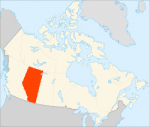Alberta Breaking Down the Boundaries
CompetencyWorks Blog
 Some of our friends across our northern border are experimenting with seat-time flexibility as well. Jonathan Oglesby from iNACOL just sent an article about Mother Margaret Mary Catholic High School’s experimentation with flexible time. It’s an interesting pilot as it works around the margins of seat-time providing students with weekly opportunities to design their own schedules.
Some of our friends across our northern border are experimenting with seat-time flexibility as well. Jonathan Oglesby from iNACOL just sent an article about Mother Margaret Mary Catholic High School’s experimentation with flexible time. It’s an interesting pilot as it works around the margins of seat-time providing students with weekly opportunities to design their own schedules.
It’s part of Alberta’s High School Flexibility Project aimed at increasing high school completion. They did a nice piece of work in their planning phase where they started to name and describe the different techniques related to credit flexibility. This is just the beginning list of the infinite design choices we have in front of us. Looking at this list, it’s probably time for us to make an easy to use tool to help us think strategically about these design choices as they are bound to grow as the boundaries of the traditional school system loosen up. (Please add others in the comments section so we can get a good list going in order to save time having to start from scratch every time).
Courses and Credits
- Self-Directed Learning Modules: Portions of, or entire courses, that are made available to students to work through at their own pace.
- Condensed Classes/Compacting Curriculum: Providing less than 25 hours per credit for classes. Such a practice requires a review of the traditional delivery of courses in order to “compact” the program outcomes into less time.
- Expanded Classes: Providing more than 25 hours per credit for classes.
- Credit Recovery: Making allowances for students who have not successfully completed a course to continue their coursework beyond the time scheduled.
Scheduling
- Alternative Bell Schedule: Schools are planning for scheduled time that is a significant departure from the traditional 4-block schedule (4 blocks of time scheduled in each semester).
- Flex Blocks: Dedicating a portion of scheduled time for students to direct their learning. During these times, all teachers are available and students are free to choose with whom and where to work.
- Classes “outside” of the Timetable: Courses offered outside of the time regularly scheduled for students.
Content, Curriculum and Instruction
- Project-Based Learning: Students meet program outcomes by engaging in inquiry-focused projects with a real-life application. Often these projects are multi-disciplined studies.
- Use of Technology: Plans that incorporate intentional uses of technology to support student learning or develop digital collaborative spaces.
- Interdisciplinary Courses/Projects: Courses or projects that are designed to meet outcomes from more than one discipline.
- Flexible Career and Technology Studies (CTS): Allowing students to design CTS courses based on their interest in specific modules and providing the opportunity for students to progress through modules at their own pace.
- Partnerships with the Community: Planned partnerships for students to learn collaboratively with the community outside of the school.
Roles, Relationships, and Support for Teachers
- Time for Teacher Collaboration: Providing time during the regularly scheduled day for teachers to meet.
- Micro-Scheduling by Teachers: Allowing a group of teachers to completely manage the time available for several areas of instruction rather than time being determined by the school schedule.
- Team Teaching: Scheduling a group of teachers to provide instruction to a group of students.
- Teacher Advisory: Providing time in the timetable for teachers to work with a specific group of students to provide guidance and advice.
School Structure
- Small School Academies: Organizing the school into sub-units with a specific group of students working with a specific set of teachers.
Some of the barriers Alberta has identified are timing of examinations (they’ve added two more opportunities for students to take exams in November and April as well as January and June); rigid programs of study (they are opening up the door to inter-disciplinary and project-based learning); and of course the two big ones — accountability and funding.